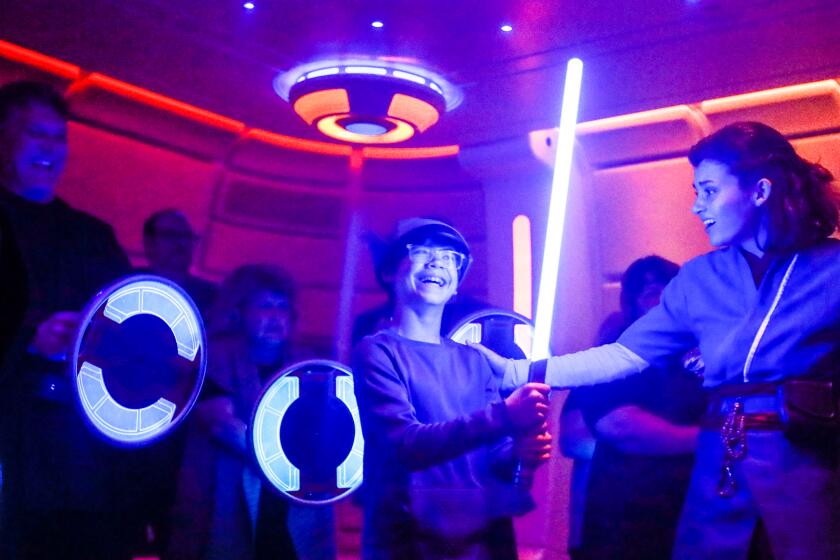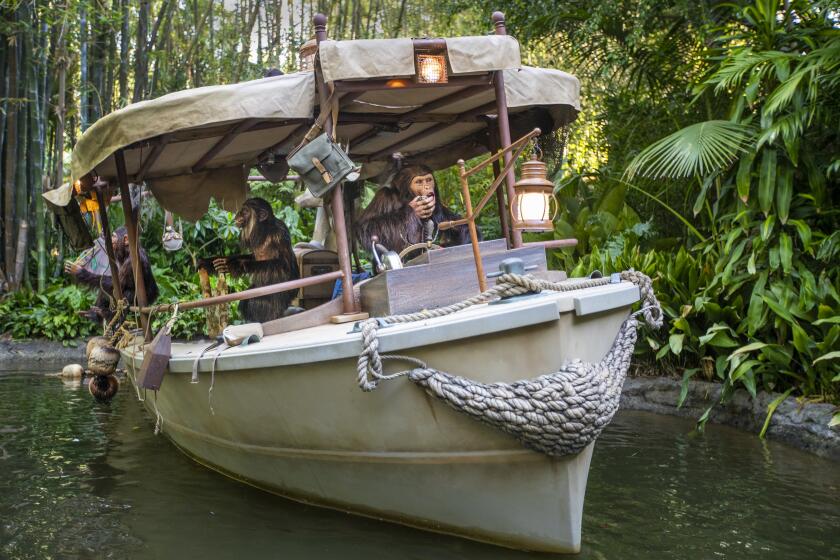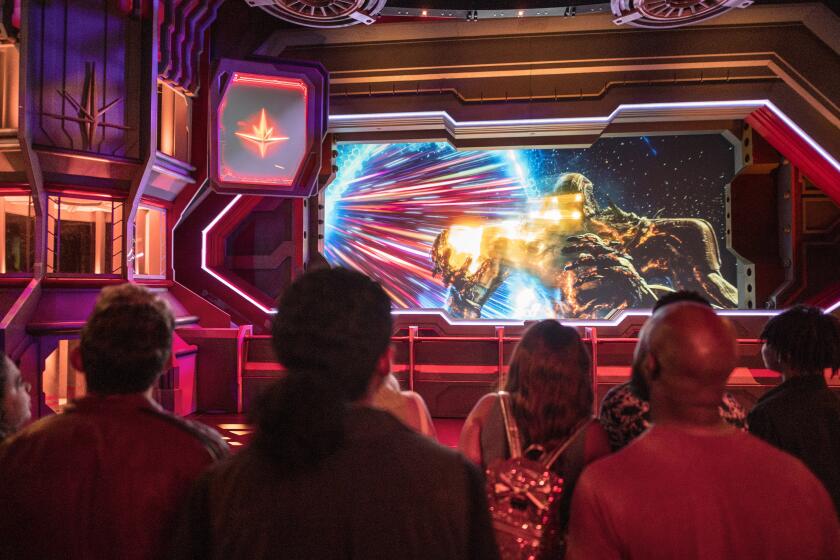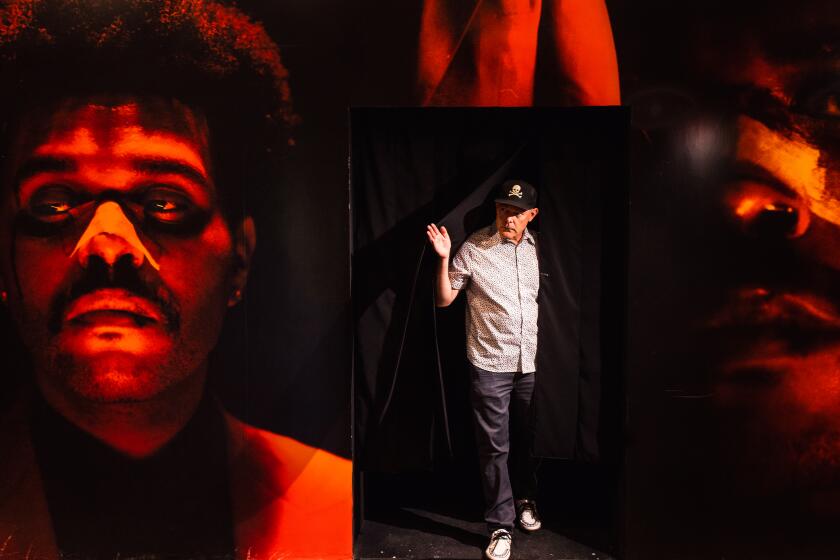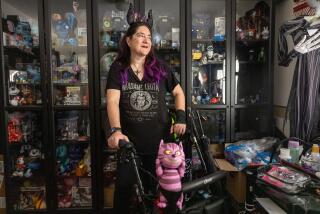The Disney myth will be on display at D23 Expo. Here’s why we want to believe it
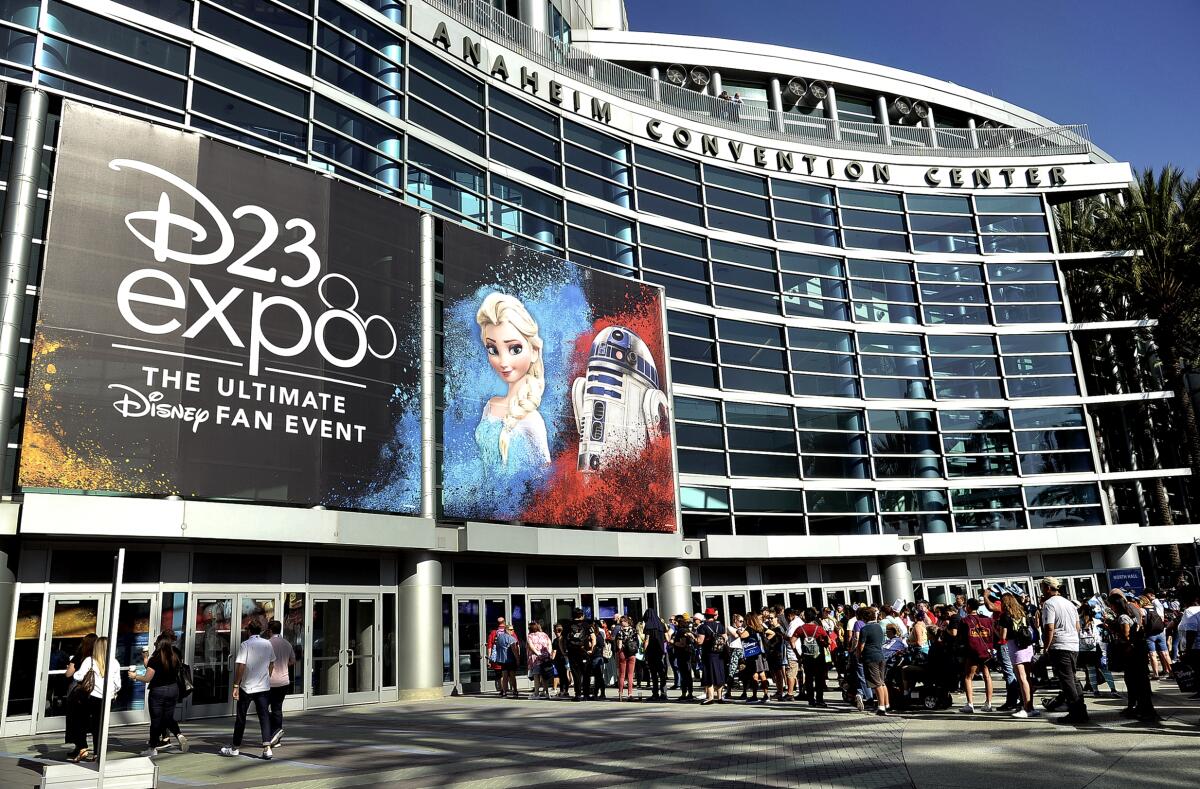
By now, most everyone is aware that there are two distinct Walt Disney Co.s.
One is a business empire with a formidable, risk-averse marketing department. The other lives in our collective imagination, that part of us that deeply wants to believe in the fantasy and magic imbued in the foundation of Disney’s creative content. It’s more than a belief in fairy tales; it’s the promise of what humanity could be and a reflection of how we hope to see ourselves.
Those dual aspects of Disney rarely converge on a public stage, but there’s one place that readily embodies the company’s carefully calculated balancing act between its two sides: Disney’s sold-out fan convention, the D23 Expo. Now it’s back at the Anaheim Convention Center where, after a year off because of the pandemic, the faithful have once again paid around $100 per day to wait in long lines to witness what’s next for Marvel, Lucasfilm and Disney’s theme parks.
Expect some added reflection at this year’s D23 Expo. The event is ground zero for the launch of the Walt Disney Co.’s 2023 centennial celebration. Think of it as a marketing bonanza, but from an unparalleled entertainment conglomerate that has influenced generations, defined American culture and honored its own traditions while changing with the times.
A number of panels and displays at this year’s D23 Expo will look back at the legacy of Disney. Consider a museum-like exhibit that will seek to re-create the company’s most storied moments, such as the 1937 premiere of “Snow White and Seven Dwarfs,” or presentations that will honor everything from the 40th anniversary of video game film “Tron” to a deep dive on the adventures of Walt Disney’s company plane, the construction of Florida’s Walt Disney World, or even the futuristic optimism of the company’s Midcentury Modern period.
All the while, the hope is that the current creative and executive leadership of the Walt Disney Co. are in the midst of plotting such moments for the next 100 years. But in the always-on, social media driven era of 2022, the future comes fast, and there’s no denying that we look to entertainment companies for societal stewardship. D23 Expo is arriving at a time when the company is realigning its business with streaming service Disney+ as the backbone, the centerpiece of the company’s “synergy machine,” to quote Chief Executive Bob Chapek.

But magic, myth and marketing have competing interests and can sometimes clash. D23 Expo is a chance for the company to argue they’re in alignment. After a rocky few months that found the company in political crosshairs, debates surrounding Disney are back to more familiar topics, namely whether its products, especially its theme parks, are pricing out its fans.
There has, of course, been no indication that demand for Disneyland is slowing after an extended 13-month pandemic-related closure. The company has even noted that guest spending at its resorts is up significantly as new features, like line-skipping add-ons such as Genie+ and individual Lightning Lanes, turn more aspects of the park into a transaction.
The latter are worthy of examination. As more park perks gradually become gated behind additional purchases, does Disneyland become less representative of American storytelling and more a reflection of its class system? Consider it an example of where there’s tension between Disney’s narrative prowess and its business interests. Expect that to be a robust debate among fans at its convention, even if it isn’t defended on any stages.
Here’s what you will find at the D23 Expo: Treatises on the lively “The Muppets Christmas Carol” or the once-again-retired but never out of style Main Street Electrical Parade at Disneyland. What you won’t: Little, if any, modern corporate contemplation.
This trait is an indication of the company’s success, that its good ideas — the high-art aspirations of “Fantasia,” the world-building of Disneyland or the reinvention of the hotel with the Star Wars Galactic Starcruiser, among just a tiny few — continue to grow beyond any corporate branding and can alter the course of art and culture. At their best, they speak to the human experience, the idea that we make sense of the world via the stories we tell.
It may be the most ambitious Disney theme park endeavor since Disneyland: Star Wars: Galactic Starcruiser, a live-action role-playing game for the 1%.
It’s also why recent history, such as Disney’s pandemic responses, its entanglement in Florida politics or its quick reaction to stand by its employees affected by the Supreme Court’s reversal of Roe vs. Wade, inspired national headlines. It’s not because Disney is controversial — rarely these days — but more representative of the emotional connection Disney’s output inspires. We don’t just want to believe in Disney’s myths. We want to know that the company itself adheres to them.
The company survived, for instance, its back and forth with the Florida government, which began after fans and employees called for Disney to vocally oppose what was widely perceived as anti-gay legislation, the so-called “don’t say gay” bill. It took Disney a moment to get the messaging right, but this blew up in part because taking the marketing-way-out — the neutral path — doesn’t cut it for a company that traffics in idealism.
Chapek has said, “I believe the best way for our company to bring about lasting change is through the inspiring content we produce, the welcoming culture we create, and the diverse community organizations we support.” There is truth in that statement. That content — and the fact that so much of what Disney has produced in the last 100 years is tied up in various aspects of our lives — is the company’s power.
And on the verge of turning 100, the Walt Disney Co. has itself become a thing of folklore, which presents an oft unspoken challenge for modern company leaders. Or an opportunity to turn a vintage Grumman Gulfstream I, which once essentially served as the personal plane of company patriarch, Walt Disney, into a tourist attraction and merchandise opportunity.
The Gulfstream will be present on the expo floor, where it will be treated as a storytelling device. The aircraft once scouted locations for Walt Disney World, transported company luminaries to the 1964 World’s Fair and even appeared in a few Disney films. It could be considered an odd sight for a fan convention, but its presence here underscores the importance the Walt Disney Co. has held to our country — even its vehicles are treated with a mythmaking reverence once reserved for political dignitaries.
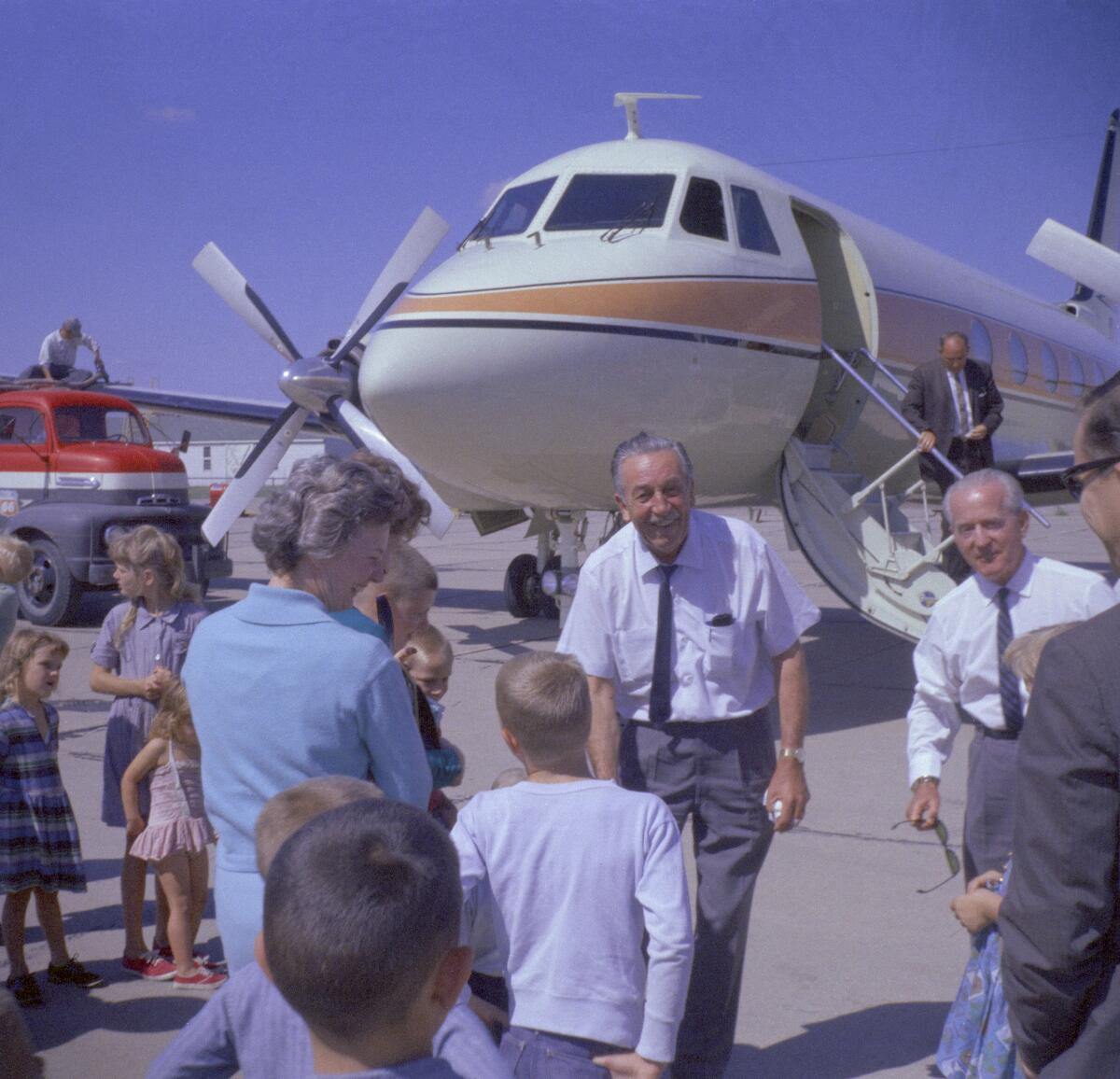
When it comes to the D23 Expo’s signature exposition — a presentation from the company Archives division called “Step in Time” — the team didn’t take a point-by-point, fact-by-fact approach. Nor are they doing so for “Disney100: The Exhibition,” which will have its premiere next February at the the Franklin Institute in Philadelphia and will be previewed at the D23 Expo (the latter, like many D23 Expo panels, will be live-streamed). Such a task, says Rebecca Cline, director of the Walt Disney Archives, would be “impossible.” It’s also perhaps a way to avoid dealing with more difficult aspects of the company’s history.
“We’re looking at storytelling as a basic premise, and that was from Walt,” Cline says of the Philadelphia exhibition. “So there’s a gallery just about storytelling. There’s a gallery about the importance of music. There’s one about the experience of being in the parks. There’s a gallery about personality in animation, which is something Walt started, creating characters you had an emotional connection to. ... We’re doing the same kind of thing in ‘Step in Time,’ to a smaller degree.”
That means an exhibit on the 1950s at D23 Expo will look at the launch of Disneyland. “We’re re-creating what it was like to walk into the gates at Disneyland,” Cline says. “You can walk in and see the posters — a lot of original posters from the opening of the park — set up so that you can see what it was like to walk in and see the floral Mickey and the train station. You can have that moment of experiencing maybe what it was like to be the first kid at Disneyland.”
The new Jungle Cruise shows Disney wants to be in the cultural conversation rather than an artifact or, worse, a representation of the ‘good ole days.’
Instead of just showing us facts and figures, Cline and her team sought to create a simulacrum of what Disneyland looked like during its July 1955 opening. Don’t write it off as nostalgia. Disneyland is arguably America’s most recognizable export.
The park’s key ingredient is the way it has shifted with the times. Disneyland has represented our dreams, fears and ideals, whether that’s turning Western images of death into lighthearted tuneful fare (the Haunted Mansion), placing romantic ideals alongside images of hard work and perseverance (Snow White’s Enchanted Wish) or recognizing at long last that its attractions need to better reflect the diverse audiences who visit them (changes to the Jungle Cruise or the remaking of Splash Mountain into a ride themed to “The Princess and the Frog”).
Disneyland itself was born of its time, representative of a post-WWII America that was adjusting to more internalized, less overtly visible fears, and has forever remained a balm for our country’s dark moments. Through Vietnam, the AIDS crisis, the economic crash of 2008 and now COVID-19, Disneyland and the Walt Disney Co. have survived, sometimes awkwardly so, such as the former having to once aggressively distance itself from its history of a less-than-welcome approach to same-sex couples by staging a large fundraiser in 1987 for AIDS Project Los Angeles.
And yet we trust that Disney will ultimately get things right, even when it requires a bit of patience.
Not because we’re shills or fell for a marketing scheme. No, amid an often confusing, divisive century, Disney stories and theme parks have been telling us there’s a happily ever after. We buy into that magic because it’s worth believing in, and fans line the Anaheim Convention Center halls — or take Disney to task for where it spends its political dollars, how it pays its employees and how it prices its theme parks — because the spell is broken if a better, more inclusive and progressive world isn’t the goal for all parties involved.
A review of the new Guardians of the Galaxy: Cosmic Rewind ride at Walt Disney World’s Epcot.
Disneyland Imagineers anticipated criticism of the inclusion of ‘true love’s kiss’ in its Snow White ride redo. How they worked to empower Snow White.
We talk to John Murdy, the architect of Universal’s Halloween Horror Nights, on transforming the emotional terror of the Weeknd’s music into a horror attraction.
More to Read
The biggest entertainment stories
Get our big stories about Hollywood, film, television, music, arts, culture and more right in your inbox as soon as they publish.
You may occasionally receive promotional content from the Los Angeles Times.
